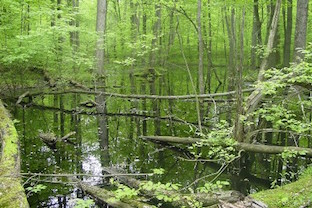 On February 2nd, we celebrate World Wetlands Day. You may be wondering, what is there to celebrate? A lot actually! On February 2nd, 1971, The Convention on Wetlands was held and its mission statement was “the conservation and wise use of all wetlands through local and national actions and international cooperation, as a contribution towards achieving sustainable development throughout the world.” In Ohio, only 10% of the once abundant wetland habitat remains. In pre-industrial times, northwest Ohio was home to the Great Black Swamp, a vast stretch of wetlands and woodlands that housed a wide variety of plants and animals. As more and more European settlers arrived in the region, they began to drain the Swamp for agricultural purposes. This resulted in some of the most productive farmland in the country, at the expense of The Great Black Swamp and its wetlands. However, wetland habitat still remains in our area, both original and restored, and can be found in coastal areas along Lake Erie, like Magee Marsh, and in Metroparks like Oak Openings and Pearson Park.
On February 2nd, we celebrate World Wetlands Day. You may be wondering, what is there to celebrate? A lot actually! On February 2nd, 1971, The Convention on Wetlands was held and its mission statement was “the conservation and wise use of all wetlands through local and national actions and international cooperation, as a contribution towards achieving sustainable development throughout the world.” In Ohio, only 10% of the once abundant wetland habitat remains. In pre-industrial times, northwest Ohio was home to the Great Black Swamp, a vast stretch of wetlands and woodlands that housed a wide variety of plants and animals. As more and more European settlers arrived in the region, they began to drain the Swamp for agricultural purposes. This resulted in some of the most productive farmland in the country, at the expense of The Great Black Swamp and its wetlands. However, wetland habitat still remains in our area, both original and restored, and can be found in coastal areas along Lake Erie, like Magee Marsh, and in Metroparks like Oak Openings and Pearson Park.
Wetlands have several important functions. They act as storage facilities for water during and after large rain events, helping to prevent flood damage and erosion. They are capable of absorbing and holding substantial amounts of water, and then slowly release it over time. Wetlands also act as natural filters for the water that enters their systems. As water is retained in the wetland, suspended sediments are able to drop out and nutrients, such as those coming from fertilizer, are consumed by plants and microorganisms. Eventually, the water is released into the ground below or into a nearby waterway, with better water quality than when it entered the wetland. Wetlands are also extremely productive biologically, acting as homes for many different plants and animals. Local wetlands, like those in Oak Openings and along Lake Erie, are home to a variety of plants, insects, frogs, turtles, fish, and mammals and are stops on migratory routes for thousands of birds each year. Wetlands are an extremely important part of our local water system, one that should be celebrated and protected. Go discover your local wetlands!
